China Automotive Multimodal Interaction Development Research Report, 2021
Our China Automotive Multimodal Interaction Development Research Report, 2021 combs through and summarizes the interaction modes of mainstream auto brands.
The current automotive human-computer interaction (HMI) is characterized by the following:
1. In terms of interaction modes, in addition to conventional interaction methods such as touch control, button and knob, voice and mobile phone have become favored options in automotive HMI. Moreover, face, gesture, and car lamp have also become popular interaction options. Some brands even have begun to try new interaction ways, such as eye tracking, voiceprint, and fingerprint.
2. As concerns layout, joint-venture brands remain conservative in interaction modes. They seldom use new interaction methods except for voice and mobile phone. Yet luxury brands are pioneers of multimodal interaction. One example is Mercedes-Benz which has equipped its new-generation MBUX system with multiple new interactions like face, gesture, eye, and fingerprint. By comparison, Chinese leading brands are more active in new interaction modes, for example, Changan Auto has eyesight wake-up and Great Wall Motor offers voiceprint recognition.
Some HMI modes of mainstream auto brands inside and outside China:
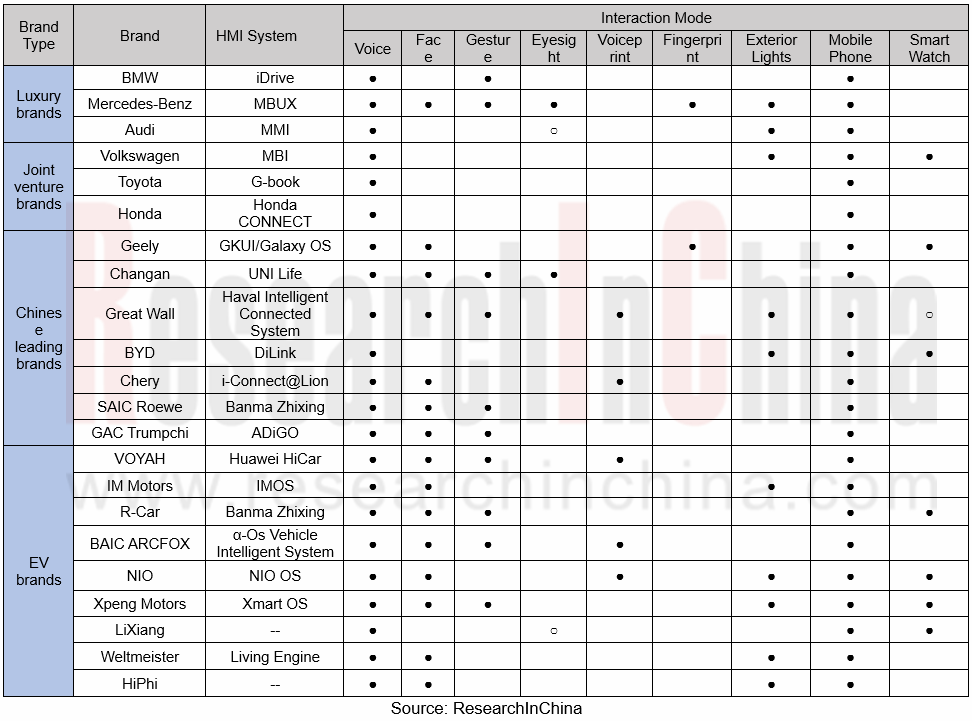
Voice as a conventional interaction mode offers improvements in functions.
Besides the original capabilities of voice interaction, features like continuous dialogue, voice area lock, tone switch, and user-defined voice have become next orientations of mainstream brands.
1. Continuous dialogue and voice area lock have been used by several brands.
After a wake-up, a voice interaction system with the continuous dialogue capability needs no repeated wake-up within a certain period of time, which makes the response to instructions more coherent; the voice area lock feature with the ability to locate the voice command issuer, executes commands like “open window” and “adjust air conditioning temperature” more accurately. The brands using the two features include Geely, Changan, Great Wall, Chery, SAIC Roewe, GAC Trumpchi, Xpeng, NIO and Lixiang.
Geely Xingyue L - the “driver geek mode” of Galaxy OS frees the driver of wake-up in 24 hours, and enables lock of four voice areas.

Xpeng Motors – the voice assistant Little P delivers voice functions in all scenarios and allows 30s continuous dialogue and dual-voice area lock.
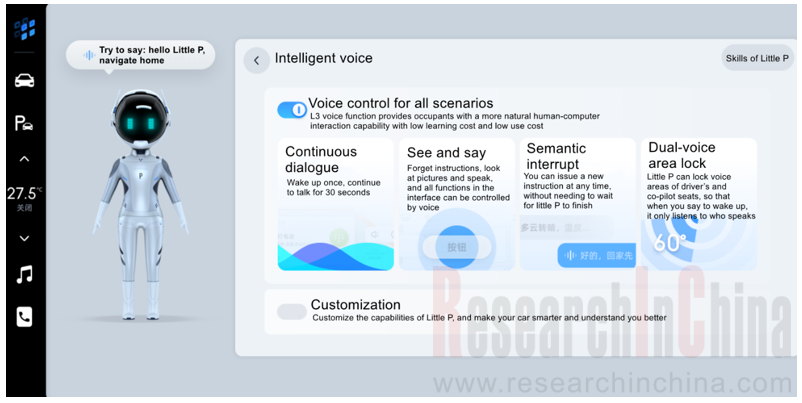
2. Tone switch refers to the availability of other speech options the voice system provides for users in addition to default voices and sounds, such as, voices of celebrities and game characters. The brands with this feature include Geely, Changan, Great Wall, BYD and Roewe, as well as emerging carmakers like NIO, Xpeng and Lixiang. For instance, Banma Zhixing Venus System mounted on SAIC Roewe RX5 offers five tone options: affinity female voice, intellectual female voice, magnetic male voice, innocent child voice, and passionate female voice.
3. User-defined voice feature allows customization of voice tones and voice functions.
“Voice tone customization” means that the system applies the uploaded voices of the user’s own or his/her families’ in scenarios such as voice response and navigation broadcast. Models carrying this capability include Geely, Great Wall, SAIC Roewe, GAC Trumpchi and R Car.
“Voice function customization” means that users can define a voice command as well as corresponding operation, which brings the voice system into full play and meets the personalized needs of users. The typical brand using this capability is Xpeng Motors.
Geely Xingyue L - Galaxy OS allows users to define voice. The customized human voice is available to all scenarios including navigation and response.
Xpeng Motors - Little P Customization allows Xpeng car owners to define voice commands and corresponding operation via their smartphone APP.
Gesture has become the third new interaction mode behind voice and face.
Gesture interaction uses the in-car camera to judge a gesture and send the data to the vehicle system control unit which will then call out the function corresponding to the gesture. Gesture control is more accurate and quicker, and easier to operate than voice control.
Brands using gesture interaction include BMW, Mercedes-Benz, Changan, Great Wall, SAIC Roewe, GAC Trumpchi, VOYAH, R Car, BAIC ARCFOX, and Xpeng, of which Great Wall and Xpeng support gesture recognition outside car.
WEY Mocha – enable gesture control over ignition, forward/backward movement, suspension, and flameout outside the car.
Changan Ford EVOS - the new-generation SYNC+ 2.0 allows gesture control over muting, music play, interface split, and back to the home interface, etc.
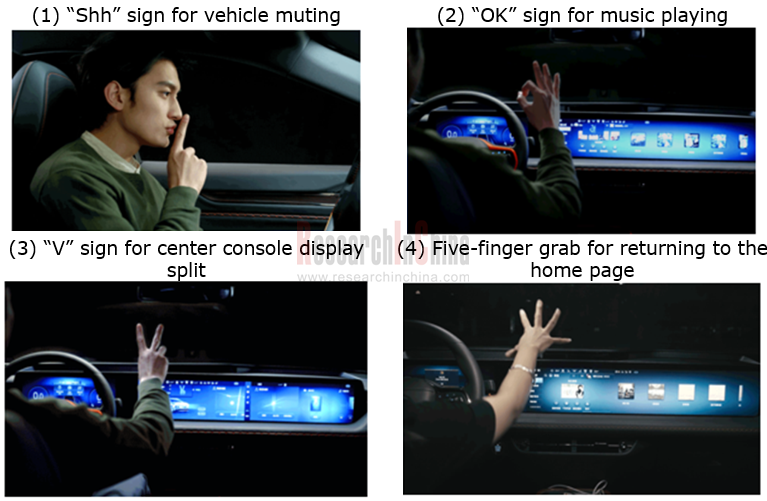
Light interaction is available to brands like Mercedes-Benz, HiPhi and IM Motors.
Light interaction sends a message out by way of flashing, light projection and combination headlight. Light interaction provides channels for communication with traffic participants outside the car, and enables autonomous vehicles to communicate with the surroundings at a time of implementing autonomous driving. Now brands including Mercedes-Benz, Audi, Volkswagen, Great Wall, BYD, HiPhi, IM and Xpeng have packed this interaction mode.
Mercedes-Benz - Projector headlights project warning signs, assisted markings and other information related to driving assistance systems onto the road ahead.
IM L7 - Projection headlights enable the projection of interactive alerts, navigation, vehicle information among others, offering lane-level guidance with HD maps.; combination headlights provide several patterns to show the status of users in the cockpit; interactive taillights enable display of words and emoticons, as well as information, for example, thanks, pedestrian warning and state of charge.
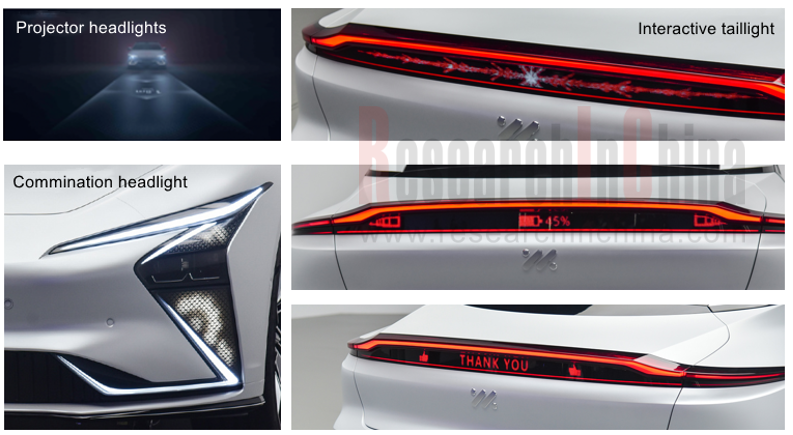
As well as combination headlights, some brands like BAIC and Samsung are trying to add displays at the front and rear of the body to send messages to pedestrians.
BAIC Lite 300 – LED displays at the front and rear of the body show words, emoticons, animations, state of charge and other content.
Multimodal fusion holds a future trend.
Single-modal interaction has a limited role to play in improvement of interaction experience. Multimodal fusion is obviously a feasible and efficient option for better interaction experience in future. Brands that are developing this feature are Mercedes-Benz, BMW, Huawei and Changan.
1. Voice + eye sight
Voice interaction shows little ability to recognize fuzzy pronouns like “this” and “that”. In this case, the addition of eye tracking for locking direction, plus voice commands, can make the response to commands much quicker.
Mercedes-Benz MBUX Travel Knowledge – a driver who fixes his/her gaze on a building says “I want to know the purpose of this building”, and he/she will acquire related information. Cerence Look provides technical support.
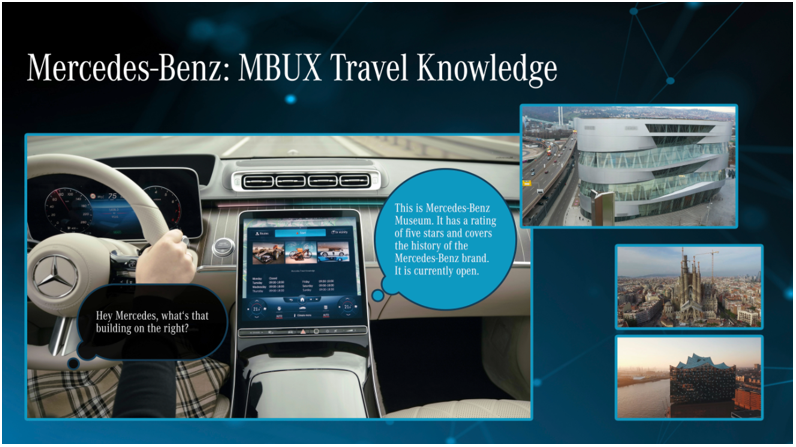
2. Voice + lip movement recognition
Accurate acquisition of commands is a key step in the voice interaction process. Complex cockpit environment, noise and high personnel density make it harder to recognize voice. The new voice area lock feature added recently comes as a solution to the problem. Yet for its limitations, the single-model voice interaction technology has a limited effect in improving interaction experience.
The combination with lip movement recognition renders voice recognition far more accurate in voice interaction. Lip movements vary over language. In a noisy cockpit environment, combining lip movements, the system can ensure high voice recognition accuracy, even as the voice sounds low.
China Automotive Lighting and Ambient Lighting System Research Report, 2025
Automotive Lighting System Research: In 2025H1, Autonomous Driving System (ADS) Marker Lamps Saw an 11-Fold Year-on-Year Growth and the Installation Rate of Automotive LED Lighting Approached 90...
Ecological Domain and Automotive Hardware Expansion Research Report, 2025
ResearchInChina has released the Ecological Domain and Automotive Hardware Expansion Research Report, 2025, which delves into the application of various automotive extended hardware, supplier ecologic...
Automotive Seating Innovation Technology Trend Research Report, 2025
Automotive Seating Research: With Popularization of Comfort Functions, How to Properly "Stack Functions" for Seating?
This report studies the status quo of seating technologies and functions in aspe...
Research Report on Chinese Suppliers’ Overseas Layout of Intelligent Driving, 2025
Research on Overseas Layout of Intelligent Driving: There Are Multiple Challenges in Overseas Layout, and Light-Asset Cooperation with Foreign Suppliers Emerges as the Optimal Solution at Present
20...
High-Voltage Power Supply in New Energy Vehicle (BMS, BDU, Relay, Integrated Battery Box) Research Report, 2025
The high-voltage power supply system is a core component of new energy vehicles. The battery pack serves as the central energy source, with the capacity of power battery affecting the vehicle's range,...
Automotive Radio Frequency System-on-Chip (RF SoC) and Module Research Report, 2025
Automotive RF SoC Research: The Pace of Introducing "Nerve Endings" such as UWB, NTN Satellite Communication, NearLink, and WIFI into Intelligent Vehicles Quickens
RF SoC (Radio Frequency Syst...
Automotive Power Management ICs and Signal Chain Chips Industry Research Report, 2025
Analog chips are used to process continuous analog signals from the natural world, such as light, sound, electricity/magnetism, position/speed/acceleration, and temperature. They are mainly composed o...
Global and China Electronic Rearview Mirror Industry Report, 2025
Based on the installation location, electronic rearview mirrors can be divided into electronic interior rearview mirrors (i.e., streaming media rearview mirrors) and electronic exterior rearview mirro...
Intelligent Cockpit Tier 1 Supplier Research Report, 2025 (Chinese Companies)
Intelligent Cockpit Tier1 Suppliers Research: Emerging AI Cockpit Products Fuel Layout of Full-Scenario Cockpit Ecosystem
This report mainly analyzes the current layout, innovative products, and deve...
Next-generation Central and Zonal Communication Network Topology and Chip Industry Research Report, 2025
The automotive E/E architecture is evolving towards a "central computing + zonal control" architecture, where the central computing platform is responsible for high-computing-power tasks, and zonal co...
Vehicle-road-cloud Integration and C-V2X Industry Research Report, 2025
Vehicle-side C-V2X Application Scenarios: Transition from R16 to R17, Providing a Communication Base for High-level Autonomous Driving, with the C-V2X On-board Explosion Period Approaching
In 2024, t...
Intelligent Cockpit Patent Analysis Report, 2025
Patent Trend: Three Major Directions of Intelligent Cockpits in 2025
This report explores the development trends of cutting-edge intelligent cockpits from the perspective of patents. The research sco...
Smart Car Information Security (Cybersecurity and Data Security) Research Report, 2025
Research on Automotive Information Security: AI Fusion Intelligent Protection and Ecological Collaboration Ensure Cybersecurity and Data Security
At present, what are the security risks faced by inte...
New Energy Vehicle 800-1000V High-Voltage Architecture and Supply Chain Research Report, 2025
Research on 800-1000V Architecture: to be installed in over 7 million vehicles in 2030, marking the arrival of the era of full-domain high voltage and megawatt supercharging.
In 2025, the 800-1000V h...
Foreign Tier 1 ADAS Suppliers Industry Research Report 2025
Research on Overseas Tier 1 ADAS Suppliers: Three Paths for Foreign Enterprises to Transfer to NOA
Foreign Tier 1 ADAS suppliers are obviously lagging behind in the field of NOA.
In 2024, Aptiv (2.6...
VLA Large Model Applications in Automotive and Robotics Research Report, 2025
ResearchInChina releases "VLA Large Model Applications in Automotive and Robotics Research Report, 2025": The report summarizes and analyzes the technical origin, development stages, application cases...
OEMs’ Next-generation In-vehicle Infotainment (IVI) System Trends Report, 2025
ResearchInChina releases the "OEMs’ Next-generation In-vehicle Infotainment (IVI) System Trends Report, 2025", which sorts out iterative development context of mainstream automakers in terms of infota...
Autonomous Driving SoC Research Report, 2025
High-level intelligent driving penetration continues to increase, with large-scale upgrading of intelligent driving SoC in 2025
In 2024, the total sales volume of domestic passenger cars in China was...